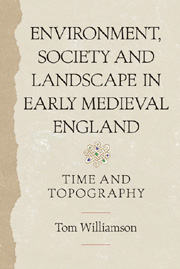Book contents
- Frontmatter
- Contents
- List of Illustrations
- Acknowledgements
- Introduction
- 1 Settlement and Society
- 2 Nature's Frame
- 3 Culture, Ethnicity and Topography
- 4 Small Shires, Deep Roots
- 5 The Gradient of Freedom
- 6 Two Countrysides?
- 7 Village, Farm and Field
- 8 Landscape and Settlement
- 9 Woodland and Pasture
- Conclusion: Time and Topography
- Bibliography
- Index
- ANGLO-SAXON STUDIES
8 - Landscape and Settlement
Published online by Cambridge University Press: 05 April 2013
- Frontmatter
- Contents
- List of Illustrations
- Acknowledgements
- Introduction
- 1 Settlement and Society
- 2 Nature's Frame
- 3 Culture, Ethnicity and Topography
- 4 Small Shires, Deep Roots
- 5 The Gradient of Freedom
- 6 Two Countrysides?
- 7 Village, Farm and Field
- 8 Landscape and Settlement
- 9 Woodland and Pasture
- Conclusion: Time and Topography
- Bibliography
- Index
- ANGLO-SAXON STUDIES
Summary
It has become fashionable amongst some researchers to emphasise the role of human agency in the formation of landscapes. Forms of field and settlement were not determined by the environment, natural or social, but were instead the consequence of choices made by social actors. Accepting for a moment the usefulness of such an approach, we might begin this stage of our enquiry by asking what kinds of factors may have influenced the decisions made by early-medieval people, whether peasants or members of a social elite, concerning where they should live; and in particular over whether manors, farms and cottages should remain in close proximity as cultivation expanded, or whether they should disperse across the landscape. I emphasise the plural – factors. In different circumstances, two, three or more aspects of the environment may have encouraged peasant farmers (or their social superiors) to make choices which, over time, produced one form of settlement pattern rather than another.
The hydrology hypothesis
The most important environmental influence on the form and pattern of medieval settlement, but also by far the most neglected, was almost certainly water supply. Modern landscape historians either ignore this issue, or imply that it was irrelevant in the location or distribution of early settlement, presumably because water was freely available everywhere, or because for some reason ease of supply was of no concern to those deciding the sites for farms.
- Type
- Chapter
- Information
- Environment, Society and Landscape in Early Medieval EnglandTime and Topography, pp. 184 - 206Publisher: Boydell & BrewerPrint publication year: 2012



